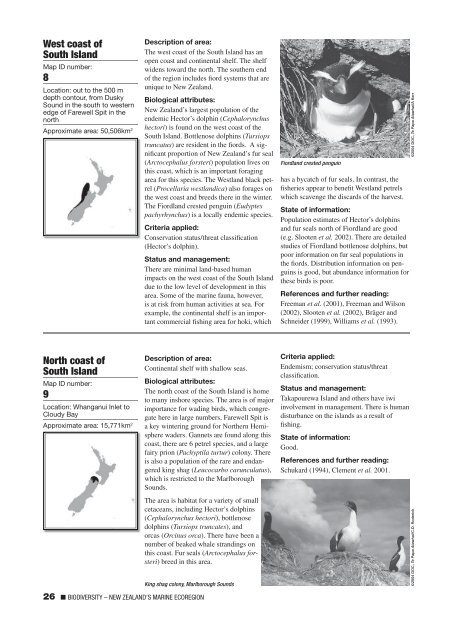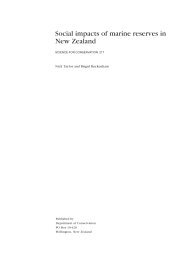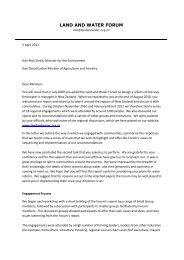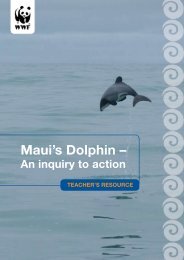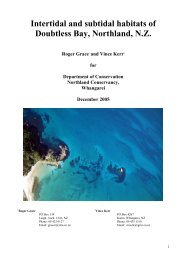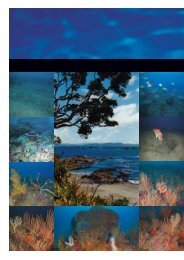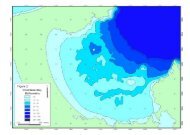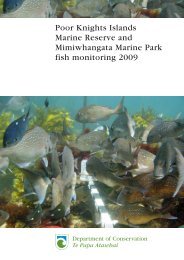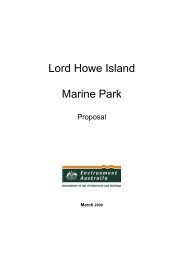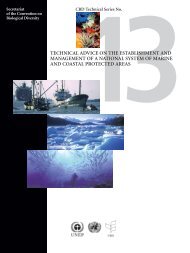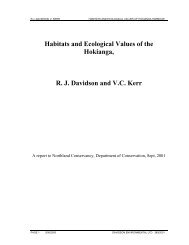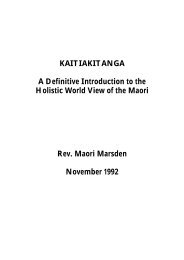WWF Shining a spotlight on the biodiversity of ... - MarineNZ.org.nz
WWF Shining a spotlight on the biodiversity of ... - MarineNZ.org.nz
WWF Shining a spotlight on the biodiversity of ... - MarineNZ.org.nz
Create successful ePaper yourself
Turn your PDF publications into a flip-book with our unique Google optimized e-Paper software.
West coast <strong>of</strong><br />
South Island<br />
Map ID number:<br />
8<br />
Locati<strong>on</strong>: out to <strong>the</strong> 500 m<br />
depth c<strong>on</strong>tour, from Dusky<br />
Sound in <strong>the</strong> south to western<br />
edge <strong>of</strong> Farewell Spit in <strong>the</strong><br />
north<br />
Approximate area: 50,506km 2<br />
Descripti<strong>on</strong> <strong>of</strong> area:<br />
The west coast <strong>of</strong> <strong>the</strong> South Island has an<br />
open coast and c<strong>on</strong>tinental shelf. The shelf<br />
widens toward <strong>the</strong> north. The sou<strong>the</strong>rn end<br />
<strong>of</strong> <strong>the</strong> regi<strong>on</strong> includes fiord systems that are<br />
unique to New Zealand.<br />
Biological attributes:<br />
New Zealand’s largest populati<strong>on</strong> <strong>of</strong> <strong>the</strong><br />
endemic Hector’s dolphin (Cephalorynchus<br />
hectori) is found <strong>on</strong> <strong>the</strong> west coast <strong>of</strong> <strong>the</strong><br />
South Island. Bottlenose dolphins (Tursiops<br />
truncatus) are resident in <strong>the</strong> fiords. A significant<br />
proporti<strong>on</strong> <strong>of</strong> New Zealand’s fur seal<br />
(Arctocephalus forsteri) populati<strong>on</strong> lives <strong>on</strong><br />
this coast, which is an important foraging<br />
area for this species. The Westland black petrel<br />
(Procellaria westlandica) also forages <strong>on</strong><br />
<strong>the</strong> west coast and breeds <strong>the</strong>re in <strong>the</strong> winter.<br />
The Fiordland crested penguin (Eudyptes<br />
pachyrhynchus) is a locally endemic species.<br />
Criteria applied:<br />
C<strong>on</strong>servati<strong>on</strong> status/threat classificati<strong>on</strong><br />
(Hector’s dolphin).<br />
Status and management:<br />
There are minimal land-based human<br />
impacts <strong>on</strong> <strong>the</strong> west coast <strong>of</strong> <strong>the</strong> South Island<br />
due to <strong>the</strong> low level <strong>of</strong> development in this<br />
area. Some <strong>of</strong> <strong>the</strong> marine fauna, however,<br />
is at risk from human activities at sea. For<br />
example, <strong>the</strong> c<strong>on</strong>tinental shelf is an important<br />
commercial fishing area for hoki, which<br />
Fiordland crested penguin<br />
has a bycatch <strong>of</strong> fur seals. In c<strong>on</strong>trast, <strong>the</strong><br />
fisheries appear to benefit Westland petrels<br />
which scavenge <strong>the</strong> discards <strong>of</strong> <strong>the</strong> harvest.<br />
State <strong>of</strong> informati<strong>on</strong>:<br />
Populati<strong>on</strong> estimates <strong>of</strong> Hector’s dolphins<br />
and fur seals north <strong>of</strong> Fiordland are good<br />
(e.g. Slooten et al. 2002). There are detailed<br />
studies <strong>of</strong> Fiordland bottlenose dolphins, but<br />
poor informati<strong>on</strong> <strong>on</strong> fur seal populati<strong>on</strong>s in<br />
<strong>the</strong> fiords. Distributi<strong>on</strong> informati<strong>on</strong> <strong>on</strong> penguins<br />
is good, but abundance informati<strong>on</strong> for<br />
<strong>the</strong>se birds is poor.<br />
References and fur<strong>the</strong>r reading:<br />
Freeman et al. (2001), Freeman and Wils<strong>on</strong><br />
(2002), Slooten et al. (2002), Bräger and<br />
Schneider (1999), Williams et al. (1993).<br />
©2004 DOC, Te Papa Atawhai/A Kerr<br />
North coast <strong>of</strong><br />
South Island<br />
Map ID number:<br />
9<br />
Locati<strong>on</strong>: Whanganui Inlet to<br />
Cloudy Bay<br />
Approximate area: 15,771km 2<br />
Descripti<strong>on</strong> <strong>of</strong> area:<br />
C<strong>on</strong>tinental shelf with shallow seas.<br />
Biological attributes:<br />
The north coast <strong>of</strong> <strong>the</strong> South Island is home<br />
to many inshore species. The area is <strong>of</strong> major<br />
importance for wading birds, which c<strong>on</strong>gregate<br />
here in large numbers. Farewell Spit is<br />
a key wintering ground for Nor<strong>the</strong>rn Hemisphere<br />
waders. Gannets are found al<strong>on</strong>g this<br />
coast, <strong>the</strong>re are 6 petrel species, and a large<br />
fairy pri<strong>on</strong> (Pachyptila turtur) col<strong>on</strong>y. There<br />
is also a populati<strong>on</strong> <strong>of</strong> <strong>the</strong> rare and endangered<br />
king shag (Leucocarbo carunculatus),<br />
which is restricted to <strong>the</strong> Marlborough<br />
Sounds.<br />
The area is habitat for a variety <strong>of</strong> small<br />
cetaceans, including Hector’s dolphins<br />
(Cephalorynchus hectori), bottlenose<br />
dolphins (Tursiops truncates), and<br />
orcas (Orcinus orca). There have been a<br />
number <strong>of</strong> beaked whale strandings <strong>on</strong><br />
this coast. Fur seals (Arctocephalus forsteri)<br />
breed in this area.<br />
King shag col<strong>on</strong>y, Marlborough Sounds<br />
Criteria applied:<br />
Endemism; c<strong>on</strong>servati<strong>on</strong> status/threat<br />
classificati<strong>on</strong>.<br />
Status and management:<br />
Takapourewa Island and o<strong>the</strong>rs have iwi<br />
involvement in management. There is human<br />
disturbance <strong>on</strong> <strong>the</strong> islands as a result <strong>of</strong><br />
fishing.<br />
State <strong>of</strong> informati<strong>on</strong>:<br />
Good.<br />
References and fur<strong>the</strong>r reading:<br />
Schukard (1994), Clement et al. 2001.<br />
©2004 DOC, Te Papa Atawhai/C.D. Roderick<br />
26 ■ BIODIVERSITY – NEW ZEALAND’S MARINE ECOREGION


